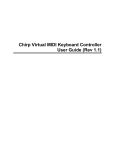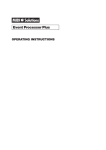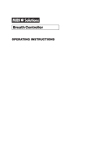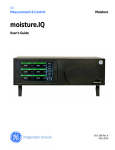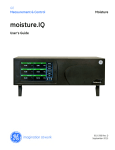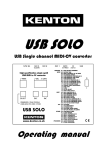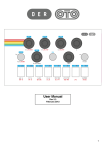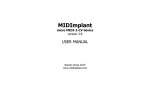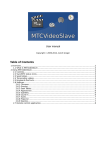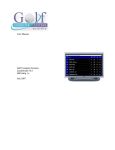Download Section 4 : Appendix
Transcript
A.16 THE APPENDICES The Quick Select Menu Pg No. Page Purpose Parameter/Function Select QSB button record type 89 QSB Data Set-up Set data value for selected data type The System Setup Menu Pg No. Page Purpose Parameter/Function 90 Internal/External Sync Select internal/external timing synchronisation 91 Controller Strip One Set-up Select assignment for “Normal” mode Select assignment for “Shift” mode 92 Controller Strip Two Set-up Select assignment for “Normal” mode Select assignment for “Shift” mode 93 Quick Select Status Set-up Quick Select on/off selector ZEIT USER MANUAL THE APPENDICES A.15 The Composer Pg No. Page Purpose Parameter/Function a6 Track Loop Part number for track loop re-start Part number for track loop point Track Loop Repeat Count a7 Select Part/Seq Part Number Sequence Number a8 Edit Part Part loop repeat count Part loop transpose amount per repeat a9 Song Status “Now playing” sequence “Now playing” part repeat count “Now playing” part transpose amount The MIDI Menu Pg No. Page Purpose Parameter/Function 95 MIDI Device Number Set unit MIDI device number 96 MIDI Forwarding Flags Forward Pitch Bend On/Off Select Forward Program Change On/Off Select Merge MIDI On/Off messages with Output Stream on/off selector 97 Sequence Number Load Range Lower MIDI program number for sequence number change Upper MIDI program number for sequence number change 98 Patch Number Load Range Lower MIDI program number for patch number change Upper number for MIDI program change number change 99 9a Transmit System Exclusive Sequence Send selected sequence data via SysEx message Transmit System Exclusive Patch Send selected patch data via SysEx message Send all sequences via SysEx protocol Send all patches via SysEx protocol The Quick Select Menu Pg No. Page Purpose Parameter/Function 87 Rename Quick Select Bank Input/rename song title 88 QSB Button Number & Record Type Select QSB button number ZEIT USER MANUAL A.14 THE APPENDICES The Keyboard Menu Pg No. Page Purpose Parameter/Function 71 Keyboard Active Range MIDI receive (rechannelised) channel External keyboard lower note value External keyboard upper note value 72 Keyboard Transpose Function Keyboard root note value Keyboard lower note value Keyboard upper note value 72 Keyboard Trigger Keyboard Trigger Mode Keyboard Trigger Note The MIDI Effects Processor Pg No. Page Purpose Parameter/Function 60 Repeat/Note Parameters Repeat count value Note pitch change per repeat Note velocity change per repeat 61 Effect Delay Time First repeat delay time (seconds) First repeat delay time (MIDI clock cycles) 62 Effect Synchronisation “Sync Delay to Tempo” on/off selector “Sync Delay to Tempo” interval selector 63 MIDI Parameters and On/Off Effects unit force-to-scale on/off selector Effects unit MIDI channel number Effects unit bypass on/off selector The Composer Pg No. Page Purpose Parameter/Function a0 Select Song Select/load named song a1 Rename Song Input/rename song title a2 Composer Status Composer on/off selector a3 Select Track Select/load named track a4 Rename Track Input/rename track title a5 Track Data Track Length (in parts) Track Active On/Off Select Track Loop On/Off Select ZEIT USER MANUAL THE APPENDICES A.13 The LFO/Sweep Generator Menu Pg No. Page Purpose Parameter/Function Sweep Generator pitch modulation on/off selector 57 Sweep Generator Modulation Routing CC1/CC2 Sweep Generator CC1 modulation on/off selector Sweep Generator CC2 modulation on/off selector The Step Input Menu Pg No. Page Purpose Parameter/Function e0 Step Time Input Note pitch value (one for each step) e1 Step Time Input Set-up Step-Time/Real-Time input mode selector Auto-skip on/off selector e2 Arpeggiator On/Off Arpeggiator on/off selector e3 Arpeggiator Set-up Arpeggiator mode selector Arpeggiator Latch mode on/off selector e4 Tap-Tempo Status Tap-Tempo status on/off selector e5 Tap-Tempo Set-up Tap-Tempo mode live/count-in selector Tap-Tempo count-in beats value e6 Tap-Tempo Live Calculated Tap Tempo Calculated count-in beats The Patch Edit Menu Pg No. Page Purpose Parameter/Function 80 Patch Rename Input/rename patch title 81 Load Patch Select/load named patch 82 Save Patch Save current patch 83 Patch Quick Select Bank Number Save all dependants Force-to-Scale Pg No. Page Purpose Parameter/Function 6a Load Scale Select/load named scale 6b Scale Edit Edit scale values (one for each note) 6c Rename Scale Input/rename scale title 6d Save Scale Save current scale ZEIT USER MANUAL A.12 THE APPENDICES The Transform Menu Pg No. Page Purpose Parameter/Function 40 Transform Rotate Select Start Step point Select End Step point 41 Transform Flip Select Start Step point Select End Step point 42 Transform Invert Select Start Step point Select End Step point 43 Transform Merge Select Start Step point Select End Step point 44 Transform Note Wrap Lower note limit Upper note limit 45 Randomise Randomise amount 47 Morph Destination Destination sequence name 48 Morph Set-up Loop forwards/alternate/off selector Dwell count 49 Morph Status Morph on/off selector The LFO/Sweep Generator Menu Pg No. Page Purpose Parameter/Function 50 LFO Rate/Depth LFO modulation rate LFO modulation depth 51 LFO Oscillator Waveshape LFO waveshape selector Oscillator synchronisation on/off selector 52 LFO Data Offsets LFO Time Offset LFO Depth Offset 53 Sweep Generator Levels Start Level percentage Target Level percentage End Level percentage 54 Sweep Generator Time Sweep Generator time value Select Sweep Generator mode 55 Sweep Generator Enable/Disable Sweep Generator running/disabled selector Sweep Generator output level 56 Sweep Generator Modulation Routing Note/Pitch Sweep Generator note modulation on/off selector ZEIT USER MANUAL THE APPENDICES A.11 The Note Editor Menu Pg No. Page Purpose Parameter/Function 05 Active Steps Step active selector (one for each step) 06 Skipped Steps Step skipped selector (one for each step) 07 Start Step/End Step Sequence start step number Sequence end step number 08 Effects Send Effects send selector (one for each step) The Controller Editors Pg No. Page Purpose Parameter/Function 10 Controller Type MIDI Controller type number 11 Controller Modulation Controller modulation direction Controller modulation depth Controller modulation on/off selector 12 Controller Values Continuous Controller value (one for each step) 13 Controller Step Active Step active yes/no selector (one for each step) 14 Controller Step Skipped Step skipped yes/no selector (one for each step) 15 Controller Start/End Step Controller Start Step number Controller End Step number The Step Editors Pg No. Page Purpose Parameter/Function 09 Step Cut Select Start Step point Select End Step point 0a Step Copy Select Start Step point Select End Step point 0b Step Paste Select Start Step point Select End Step point 0c Step Repeat Select Start Step point Select End Step point 0d Step Clear Select Start Step point Select End Step point ZEIT USER MANUAL A.10 THE APPENDICES Appendix 3: ZEIT MIDI menu summary As a quick reference for ZEIT users, the following is a summary list of all the ZEIT menu pages organised by page group, number, purpose and individual parameter/function. Note that parameters/functions shown in italics are read-only and cannot be amended. The Sequence Menu Pg No. Page Purpose Parameter/Function 30 Load Sequence Select/load named sequence 31 Save Sequence Save current sequence 32 Rename Sequence Input/rename sequence title 33 Lock/Unlock Sequence Select sequence name Locked/Unlocked sequence selector 34 Direction/Clock/Active Direction of sequence Clock rate Active/Mute sequence selector 35 Sequence Transpose Master transpose amount Keyboard transpose on/off selector 36 MIDI Parameters MIDI program number MIDI channel number MIDI volume level 37 Root Note & Octave Range Root Note Octave range 38 Force-to-Scale & Effects Send Force-to-Scale status on/off selector Effects Send status on/off selector 39 Sequence Modulation Pitch modulation percentage Velocity modulation percentage The Note Editor Menu Pg No. Page Purpose Parameter/Function 01 Note Pitch Note pitch value (one for each step) 02 Note Velocity Note velocity value (one for each step) 03 Root Note Root note value (one for each step) 04 Gate Length Gate length value (one for each step) ZEIT USER MANUAL THE APPENDICES A.9 76 Sound Control 7 77 Sound Control 8 78 Sound Control 9 79 Sound Control 10 80 Decay or General Purpose Button 1 (on/off) Roland Tone level 1 81 Hi Pass Filter Frequency or General Purpose Button 2 (on/off) Roland Tone level 2 82 General Purpose Button 3 (on/off) Roland Tone level 3 83 General Purpose Button 4 (on/off) Roland Tone level 4 Controllers 84-90 are undefined and typically available for use by synthesisers that let you assign controllers. Controllers 91 and 93 are active on nearly all general MIDI. 91 Reverb Level 92 Tremolo Level 93 Chorus Level 94 Celeste Level or Detune 95 Phaser Level The following controllers are usually reserved for data entry. We recommend that you do not your send MIDI Controller Type to any of these values. 96 Data Button increment 97 Data Button decrement 98 Non-registered Parameter (LSB) 99 Non-registered Parameter (MSB) 100 Registered Parameter (LSB) 101 Registered Parameter (MSB) These controllers are reserved. You should not use these in normal practice. 120 All Sound Off 121 All Controllers Off 122 Local Keyboard (on/off) 123 All Notes Off 124 Omni Mode Off 125 Omni Mode On 126 Mono Operation 127 Poly Operation ZEIT USER MANUAL A.8 THE APPENDICES confusing, some synths will let you assign filter cut-off to controller 22 but will still let the synth react to controller 74. Controller 32 Bank Select (LSB) - it is critical that you do not assign this controller to any other function unless, of course, you like random bank changes running through your song. These following controllers may or may not be implemented in your synth. Most likely they are not. 33 Modulation Wheel (LSB) 34 Breath controller (LSB) 36 Foot Pedal (LSB) 37 Portamento Time (LSB) 38 Data Entry (LSB) 39 Volume (LSB) 40 Balance (LSB) 42 Pan position (LSB) 43 Expression (LSB) 44 Effect Control 1 (LSB) Roland Portamento on and rate 45 Effect Control 2 (LSB) Controllers 46-63 may be in use as the LSB for controllers 14-31 in some devices, but this is rare. This group typically controls pedals. 64 Controller Hold Pedal (sustain pedal) 65 Portamento (on/off) 66 Sustenuto Pedal (on/off) 67 Soft Pedal (on/off) 68 Legato Pedal (on/off) 69 Hold 2 Pedal (on/off) This next group controls parameters on some synths. Here's where you need to closely inspect your MIDI implementation chart to see what's going on. Synths with lots of knobs may "hard assign" them to specific knobs. If you can use 71 and 74 for frequency and resonance, it's a good idea to do so. On the Korg Triton for example, controllers 71-74 are hard assigned to the knobs. If you set your more freely assignable Proteus to respond the frequency cut-off on CNTL 74, then your rig is more consistent. 70 Sound Variation 71 Resonance (aka Timbre) 72 Sound Release Time 73 Sound Attack Time 74 Frequency Cut-off (aka Brightness) 75 Sound Control 6 ZEIT USER MANUAL THE APPENDICES A.7 Appendix 2: MIDI Controller definitions The following is a list of MIDI controllers as defined in the official MIDI Specification produced by the MIDI Manufacturer's Association (MMA). Manufacturers are not required to follow this specification or fully implement it in their devices though nearly all do. The MIDI Implementation Chart in the back of your synthesiser’s manual should tell you which MIDI controllers are supported. List of Standard MIDI Continuous Controllers (CCs) 0 Bank Select (MSB) Program changes 1 Modulation Wheel (or Joystick positive polarity) (MSB) 2 Breath controller (or joystick negative polarity) (MSB) 4 Foot Pedal (MSB) 5 Portamento Time (MSB) 6 Data Entry (MSB) 7 Volume (MSB) 8 Balance (MSB) 10 Pan position (MSB) 11 Expression (MSB) The group below are sometimes "hard assigned" to faders and knobs on your synth. They are usually set as a default but you can change them to match your other synthesisers. 12 Effect Control 1 (MSB) 13 Effect Control 2 (MSB) 14 Undefined 15 Undefined 16 Ribbon Controller or General Purpose Slider 1 17 Knob 1 or General Purpose Slider 2 18 General Purpose Slider 3 19 Knob 2 General Purpose Slider 4 20 Knob 3 or Undefined 21 Knob 4 or Undefined Controllers 22 to 31 are undefined and available for use by synthesisers that let you assign controllers. With careful programming you can set them up in a consistent way so that all of your instruments will react in the same way. For example if you always assign 22 to Knob A and you always assign Knob A to filter cut-off, then all your programmable synthesisers will sweep the filter when you turn knob A no matter what synth is selected on that channel in your sequencer. This works until you get a synth that hard assigns filter cut-off to controller 74, as many General MIDI synths do. To make it more ZEIT USER MANUAL A.6 THE APPENDICES Next configure the delay between buffers to between 150 and 250 milliseconds. A delay is required so that ZEIT can write the new program data to its FLASH memory before the arrival of the next packet. If the delay isn't long enough then you might see Flash Errors or Bad Page messages on ZEIT's display. Step 4: Download the program Click on Send and wait for the program to download. MIDI Ox will send between 450 and 500 pages of data and this may take several minutes. Please be patient and make sure that the download completes and that no Bad Page or Flash Error messages appear on ZEIT's display. If you see any of these messages then please consult the Troubleshooting section above. ZEIT USER MANUAL THE APPENDICES A.5 Step 2: Enable System Exclusive messages Select the Options menu and make sure that Pass Sysex is ticked. Step 3: Configure the buffers Click on the Send File option in the menu bar. The Send-File sub-window will appear and will invite you to send a file straight away. You should select the Cancel option because the first step will be to set up the transfer options. Select the SysEx menu and click on the Configure option. Configure the low-level input and output buffers so that they are long enough to accommodate ZEIT's data messages. A setting of 512 bytes is the recommended minimum. Set the number of input and output buffers to 16 so that MIDI Ox has sufficient resources available. ZEIT USER MANUAL A.4 THE APPENDICES Checksum Errors This is almost certainly caused by a bad MIDI data connection. Check your connections, check that no other application is attempting to write to your MIDI port and check that nothing except the host computer is connected to ZEIT's MIDI In port. If you're using a MIDI distribution box or a MIDI Merge box of any type then please remove it from the link and try again. PC Users: Settings for MIDI Ox One of the best utilities we've found for upgrading ZEIT is MIDI Ox, a freeware program available from http://www.midiox.com. We strongly recommend this superb program. To use MIDI Ox in the upgrade process, follow these steps. Step 1: Make sure that MIDI Ox has recognised your MIDI Interface Click on the MIDI Devices icon and look at the list of available devices. Make sure that your interface appears in the list. If not then you will not be able to proceed with the upgrade. If this happens then you can use MIDI Ox's troubleshooting guide to help remedy the problem. In the above image, MIDI Ox has recognised an MPU 401-style device attached to the host PC's game port. ZEIT USER MANUAL THE APPENDICES A.3 6) Tell the host computer to send the update file 7) The sequencer will display the current page number and the cursor (*) will flash 8) If the page number does not display then please check the MIDI connections 9) If the transfer succeeds then the sequencer will display the following message 10) The sequencer will then boot up into the new application Troubleshooting If a problem occurs you will see an error message. Write down the error message and any error codes that are displayed for later reference. One of the following messages may be displayed: Data Transmission Errors This indicates a data transmission error. The most probable cause is either a bad connection or another program attempting to update the MIDI port. Make sure that no other applications are accessing the MIDI ports then check your connections and try again. Flash Memory Errors This indicates a possible fault with ZEIT's microprocessor because the update utility was unable to write to the microprocessor's FLASH memory. Repeat the update procedure and see if the problem occurs again. If so, try increasing the period of time between system exclusive messages. It could be that the host computer is sending data too quickly for ZEIT to receive properly. If the problems persist, then contact Infection Music or your normal support service for further advice. ZEIT USER MANUAL A.2 THE APPENDICES Upgrading ZEIT’s Firmware There are two phases to the update: Part One: Preparation 1) Check with the list of approved MIDI interfaces detailed under the software upgrades section on the Infection Music web site to ensure that your interface is suitable for upgrading ZEIT. 2) Preserve all sequence data using the system exclusive utilities detailed elsewhere in this manual 3) Download the relevant software package from the Infection Music Web site to your host computer 4) Disconnect any MIDI cables connected to the sequencer’s MIDI Out and MIDI Thru ports. Software update information is automatically forwarded via the MIDI Thru port and could upset downstream instruments 5) Connect the MIDI Out port of the host computer to ZEIT's MIDI In port 6) Ensure that the only application program running on the host computer is the update program itself 7) Ensure that MIDI clock signals have been switched off because these messages can upset the data transfer 8) Check that the transfer program can find and load the update file before you proceed 9) Locate the serial number for your instrument. This is on the rear of the instrument, near the power inlet socket. Make a note of it here, so you won’t forget it. When you have completed all of the above steps you can upgrade the software. Part Two: Upgrading the software 1) Switch off the power to the sequencer 2) If your instrument has a serial number between 001 and 999 then press and hold the Reset and Play/Stop buttons together 3) If your instrument has a serial number of 1000 and above then press and hold the Select and Enter push buttons together 4) Switch on the power to the sequencer 5) The sequencer will start up in the MISP Loader and the display will appear as follows ZEIT USER MANUAL THE APPENDICES A.1 THE APPENDICES Appendix 1: Upgrading the system software Infection Music strongly recommends that you read through this section before you attempt to perform any kind of software upgrade. Software revisions provide bug fixes and functional enhancements. Whilst every effort is made to remove bugs during our product testing and quality assurance procedures, data may be lost or corrupted during software updates. We therefore strongly recommend that you make a copy of your sequencer data before you perform any kind of software update. You can do this using the MIDI system exclusive transfer utilities detailed elsewhere in this manual. You will need the following equipment before you begin: 1) A host computer - either a PC running Windows 98, Windows ME, Windows 2000 or Windows XP or a Macintosh running OS7.1 to OS9.3 or Mac OSX - with a suitable MIDI interface 2) A software update utility or computer-based sequencer package able to load standard MIDI System Exclusive Files 3) The software update itself Software updates and utility programs can be downloaded from the Infection Music web pages at http://www.infectionmusic.co.uk Software upgrades are available in two formats: 1) MIDI System Exclusive file 2) Standard MIDI file If you are not familiar with upgrading musical instruments in this manner, do not have a suitable MIDI interface or do not have access to a download utility, then we strongly recommend that you ask a qualified service engineer to upgrade the product for you. ZEIT USER MANUAL

















